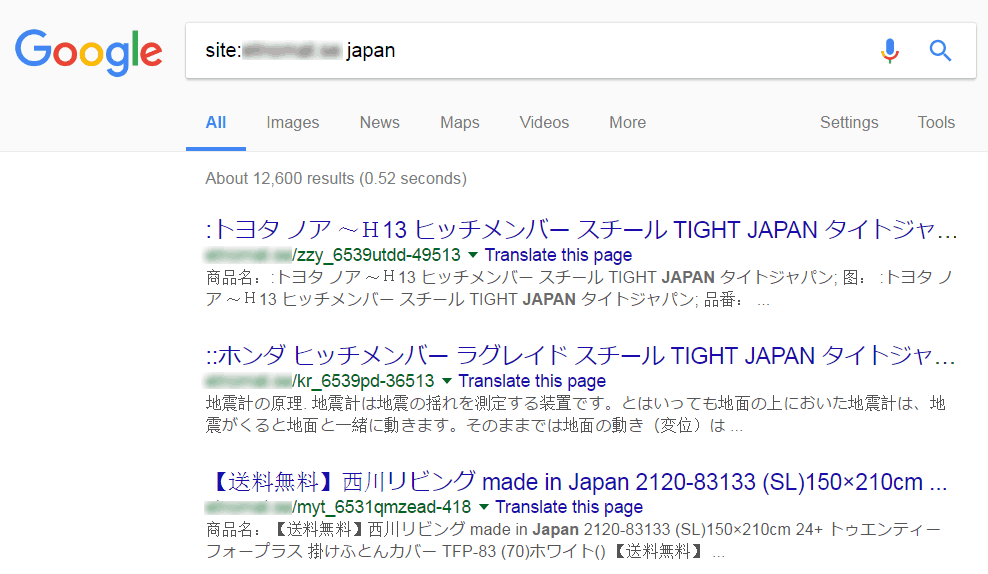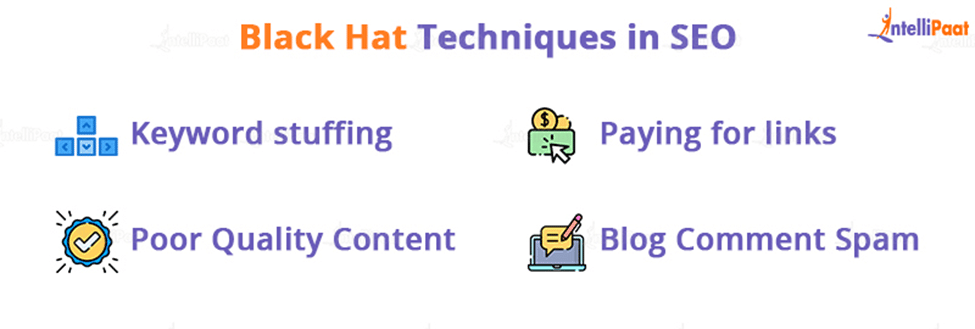Search engine optimization (SEO) is a long game. Optimizing your website to rank higher on search engine results pages will help you attract more traffic. In addition, it helps to build a trustworthy reputation. However, some people like to take shortcuts by using what is known as black hat SEO. When this happens, your business may pay the price.
What Is Black Hat SEO?
Contents
- 1 What Is Black Hat SEO?
- 2 Why Do People Use Black Hat SEO?
- 3 How Does Domain Spoofing Impact Your Business?
- 4 Reduce the Chances of Customers Visiting a Cloned Website
- 5 Restoring Your Reputation After a Spoof
- 6 What is the backlinks in SEO?
- 7 What is black hat SEO?
- 8 What is a black hat SEO quizlet?
- 9 What is cloaking in SEO with example?
- 10 What is white GREY and black hat SEO?

Black hat SEO is any activity that aims to increase the ranking and reputation of a website using methods that violate the terms of service of search engines such as Google or Bing.
In the early days of the Internet, many marketers used black hat SEO tactics to increase their visibility, attract traffic, and build trust. But as search engines evolved and tried to improve the quality of search results, they imposed penalties for unethical practices.
Now, threat actors have adopted this old-school trick to take advantage of established companies and steal from unsuspecting online shoppers.
Why Do People Use Black Hat SEO?

Honest SEO (aka white hat SEO) takes a long time to pay off. If your site ranks high for competitive keywords, you appear as a trusted brand that potential customers trust. Attackers have realized that the best way to quickly rank a site is to hijack a website with an established reputation.
Attackers can clone your website (known as domain spoofing) and then use black hat SEO tactics to drive traffic to their duplicate site. Someone can spoof a website to sell low-quality products in order to benefit from the reputation of a trustworthy store. They may also use the fake domain as part of a phishing scam. Because the fake site appears almost identical to bona fide brands, fraudsters can trick customers into sharing their credit card details.
Once thieves have your personally identifiable information, they can make fake purchases and sell your information on the dark web.
The good news is that modern analysis and anti-virus solutions can help identify phishing sites quickly. However, black hat SEO attackers can boost the rankings of a fake domain and lure unsuspecting victims before the fake site is discovered and shut down.
How Does Domain Spoofing Impact Your Business?

In the age of social proof, consumer trust is paramount. Your online reputation can make or break your business. There are serious consequences when people use black hat SEO to copy your website.
You will lose traffic. Because fake websites misdirect potential customers, your site will get fewer visitors. You’ll lose sales and see less return on your marketing spend.
Consumers will lose trust in your brand. Black hat SEO makes people land on a fake website. Next, they may find poorly spun content, spammy links, fake comments, and fraudulent ads. This bad user experience can make people look at your brand differently.
People leave bad reviews. This negative feedback may be directed at a scam site, but victims will blame you if it was under your brand name. Bad press can discourage other customers.
Search engines can penalize your business. Sometimes a real business suffers when its site doesn’t meet search engine standards. A Google penalty can kick a site out of search results. Traffic will decrease and it may take a long time to recover.
Reduce the Chances of Customers Visiting a Cloned Website

If customers fall victim to financial fraud or identity theft and believe it was your business, you could be in for a public relations nightmare.
It is best to get ahead of this danger. Here are seven steps to help you avoid black hat SEO to mislead your customers to a fake website.
Install a TLS Certificate
A Transport Layer Security (TLS) certificate is a digital security protocol that authenticates the identity of a website and establishes an encrypted connection between the website and the user’s browser. Users will see a padlock and an HTTPS prefix in your domain URL, giving them confidence that you’re keeping their personal information private and secure.
Secure Your Source Code
Ideally, your developer should add security measures to protect your website from potential attacks. One such tactic is to disable copy-paste functionality on your site so that attackers cannot easily copy your source code.
Remain Proactive
Businesses should have vigilant security teams proactively monitoring their domain and traffic for any suspicious behavior. Once you have processes and strategies in place for data processing and risk management, you can improve threat detection and protection.
Use the rel=canonical Tag
A common aspect of website spoofing is to create pages that duplicate the genuine site and then make subtle changes to the URL, such as changing a single letter. Adding the rel=canonical tag tells search engines that a particular URL is a master copy of your site’s page, making it harder for fraudsters to duplicate your site.
Study Your Website Analytics
Quite often scammers play for a quick win and it may not take time to change all the internal links. Even if visitors end up on a cloned site, they can click on links to reach the legitimate original domain. Check your website analytics for incoming traffic from a cloned site with a similar domain name.
By building a lot of internal links to your website, you can also improve your chances of finding a duplicate site. Fortunately, this is also a good SEO practice to increase your site’s performance.
Take Action
Once you’ve identified a fake site, act quickly to remove it. Please report the IP address first. Contact your hosting provider and ask them to block all requests to the fraudulent site’s IP address.
Next, send a takedown request to the service provider or content delivery network. Provide clear details about the attack and the potential threat to your business or customers.
This will also help protect your brand copyright. You can share copyrights and trademarks to speed up the takedown process and add another layer of protection to your website.
Hire a Certified Ethical Hacker
It’s much harder for someone to damage your business with black hat SEO if they can’t duplicate your domain or deface your website. Hiring a certified ethical hacker will help you find security holes and vulnerabilities and stay one step ahead.
Restoring Your Reputation After a Spoof

The tips above will help you stop scammers. But by the time these steps are taken, the effects of black hat SEO and fake websites may have already taken their toll. In a worst-case scenario, criminals sold counterfeit products, stole credit card information, and committed identity fraud on consumers, all under your brand name.
What can you do to get people to trust you again?
Address the Situation Publicly
Don’t try to hide the problem. Create content that speaks directly to your customers, letting them know you are aware of the situation and working to repair the damage.
You can create a video for YouTube or Instagram publicly apologizing to everyone who was affected. Even if it wasn’t your fault, it’s worth taking responsibility and accepting that your security team can do more to protect your customers.
Remove Fake Reviews
People using black hat SEO often add fake online reviews to increase the credibility of their fake website. Contact search engines and third-party review platforms such as Trustpilot and ask them to remove any fake reviews.
Add Multi-Factor Authentication
E-commerce stores should always have these security measures in place to protect customers. It is worth noting that the CAPTCHA system can be abused by cybercriminals. Scammers add these tests to fake domains to trick visitors into thinking they are on a legitimate and secure site.
Communicate Openly About Your Policies
Share your rules of engagement with your customers. For example, if you use two-factor authentication, make it clear so people know to expect it. If they don’t receive a two-factor authentication request on their phone or email, they may know they’re not on a genuine site.
Spoofing a site can confuse customers and steal money from them and their businesses. Keeping an eye on black hat SEO is part of good web hygiene today.
With a passion for creative writing and an unquenchable thirst to learn about futuristic technology, Christopher John Haughey’s degree in journalism became …
What is the backlinks in SEO?
A backlink is a link created when one website links to another. Backlinks are also called "inbound links" or "incoming links." Backlinks are important for SEO.
Which backlink is best for SEO? Backlinks are the most beneficial for SEO
- 1) Editorial links. …
- 2) Links to guest blogs. …
- 3) Backlinks in company profiles. …
- 4) Backlinks from webinars. …
- 5) Free tool links. …
- 6) Confirmation links. …
- 7) Guest post bio links. …
- 8) Tag links.
Why is it called a backlink?
A backlink is a hyperlink on a website that points to another website. It is called a backlink because it is a link that points to a website. Backlinks are also called inbound or inbound links.
What is the difference between links and backlinks?
What is the difference between backlinks and internal links? Backlinks are links from other websites that point to your site. Internal links are links that point from one page to another on your site. Both have SEO value, but backlinks are usually harder to get and therefore considered more valuable.
What does backlink mean?
A backlink is when one website links to another with anchor text. An example of a backlink is any article you find that links to another source or website. Examples of website backlinks can be found all over the internet, especially popular blog sites that link to relevant content.
What is backlink and why it is important?
In essence, links to your website are a signal to search engines that others vouch for your content. When many sites link to the same web page or website, search engines can conclude that the content is worth linking to and therefore is worth displaying in the SERP.
What is backlinks and its types?
A backlink is an incoming link that directs a user from one website to another. Site owners care about the smart placement of backlinks because Google uses them as a ranking factor and they, along with content, are an important part of its ranking algorithm.
How many types of backlink are there?
When you get down to it, there are only two types of backlinks: dofollow and nofollow. A person reading a website will never see the difference between a dofollow and a nofollow backlink. The difference is in the source code.
What do you mean by backlink?
A backlink is when one website links to another with anchor text. An example of a backlink is any article you find that links to another source or website. Examples of website backlinks can be found all over the internet, especially popular blog sites that link to relevant content.
What is backlinks and how it works?
A backlink is also known as a hyperlink or inbound link. In SEO, backlinks are inbound links that point from other web pages to your own web pages. Google treats these backlinks as a “stamp of approval” between the two websites. The more backlinks a page has, the more likely it is to be at the top of Google.
What are backlinks?
DA backlinks are links to your website from other high-reputation High Domain Authority (DA) sites. Domain Authority is an SEO ranking score developed by Moz to predict how likely a domain is to rank on search engine results pages (SERPs).
Do backlinks help SEO?
Backlinks are especially valuable for SEO because they represent a “vote of confidence” from one site to another. In essence, links to your website are a signal to search engines that others vouch for your content.
What is a backlink in SEO?
Links on websites other than your website that lead back to a page on your website. Backlinks are also called inbound links because they represent traffic from another website coming to your site. The quality and quantity of your backlinks can help you rank higher in search engines like Google and Bing.
What is an example of a backlink?
Backlinks are links from one website to another. When someone links to your site, you have a backlink from them. If you link to another website, they will have your backlink. For example, these words link to YouTube, so they now have a backlink from us.
What is black hat SEO?
Black hat SEO is an unscrupulous search engine optimization tactic used to illegally increase a website’s search engine results page (SERP) ranking or lower the ranking of a competitor’s site. A website’s position on the search results page can be crucial in reaching your audience.
What are examples of black hat SEO? Black hat SEO techniques, encapsulated in spam, involve manipulating how search engines perceive the relevance of a web page in ways that often go against search engine guidelines. Hidden text, obfuscation, and blog comment spamming are examples of black hat SEO.
What is a black hat SEO technique?
Black hat SEO is a practice that goes against search engine guidelines used to rank a site higher in search results. These unethical tactics do not solve the searcher problem and often result in search engine penalties. Black hat techniques include keyword stuffing, cloaking, and using private link networks.
What is a black hat SEO technique quizlet?
black hat SEO. In search engine optimization (SEO) terminology, black hat SEO refers to the use of aggressive SEO strategies, techniques, and tactics that focus only on search engines and not on the human audience, and typically do not follow search engine guidelines.
Does black hat SEO work?
Black Hat SEO is still going, working incredibly well and serving a lot of people. The downside is that it goes against all ethical guidelines, damages companies’ reputations, leads to manual penalties and ultimately blacklisting thousands of websites.
Why is it called black hat SEO?
Black hat SEO refers to a set of practices used to increase the ranking of a site or page in search engines by means that violate the search engines’ terms of service. The term “black hat” comes from Western movies to distinguish the “bad guys” from the “bad guys” wearing white hats (see white hat SEO).
What do you mean by black hat and white hat SEO?
While white hat SEO involves looking for ways to improve user experience, black hat SEO relies on manipulating Google’s algorithm to improve rankings. Simply put, if a tactic is designed to trick Google into thinking a site is providing more value to users than it actually is, it’s deceptive — and that’s black hat SEO.
Does black hat SEO work?
Black Hat SEO is still going, working incredibly well and serving a lot of people. The downside is that it goes against all ethical guidelines, damages companies’ reputations, leads to manual penalties and ultimately blacklisting thousands of websites.
Is black hat SEO good?
Instead of earning the right to rank high on search engine results pages, black hat SEO uses shady tactics to get you there. Constantly using black hat SEO techniques will hurt your search engine presence rather than improve it.
Why do people use black hat SEO?
Simply put, black hat SEO includes any technique that goes against Google’s guidelines. Some people see them as a faster way to higher rankings. In fact, many SEO practitioners believe that black hat SEO tactics are useful and encourage others to use them.
Which hat is good for SEO?
In general, white hat SEO refers to any practice that improves your search ranking on the search engine results page (SERP) while maintaining the integrity of your website and complying with the search engines terms of service. These tactics are within the boundaries defined by Google.
What is a black hat SEO quizlet?
In search engine optimization (SEO) terminology, black hat SEO refers to the use of aggressive SEO strategies, techniques, and tactics that focus only on search engines and not on the human audience, and typically do not follow search engine guidelines.
What is an example of black hat SEO? Hidden text, obfuscation, and blog comment spamming are examples of black hat SEO. White hat SEO techniques involve providing users with quality content that is accurate, relevant, and well-organized.
What is Blackhat and white hat SEO?
While white hat SEO involves looking for ways to improve user experience, black hat SEO relies on manipulating Google’s algorithm to improve rankings. Simply put, if a tactic is designed to trick Google into thinking a site is providing more value to users than it actually is, it’s deceptive — and that’s black hat SEO.
What is white hat in SEO?
White hat SEO is an approved search engine optimization tactic aimed at increasing a website’s position on the search engine results page (SERP). Search engine results that appear as a result of approved methods and not payment or fraud are called organic search results.
Which Hat is good for SEO?
In general, white hat SEO refers to any practice that improves your search ranking on the search engine results page (SERP) while maintaining the integrity of your website and complying with the search engines terms of service. These tactics are within the boundaries defined by Google.
Does black hat SEO work?
Black Hat SEO is still going, working incredibly well and serving a lot of people. The downside is that it goes against all ethical guidelines, damages companies’ reputations, leads to manual penalties and ultimately blacklisting thousands of websites.
Is black hat SEO good?
Instead of earning the right to rank high on search engine results pages, black hat SEO uses shady tactics to get you there. Constantly using black hat SEO techniques will hurt your search engine presence rather than improve it.
Which hat is good for SEO?
In general, white hat SEO refers to any practice that improves your search ranking on the search engine results page (SERP) while maintaining the integrity of your website and complying with the search engines terms of service. These tactics are within the boundaries defined by Google.
Why do people use black hat SEO?
Simply put, black hat SEO includes any technique that goes against Google’s guidelines. Some people see them as a faster way to higher rankings. In fact, many SEO practitioners believe that black hat SEO tactics are useful and encourage others to use them.
What is cloaking in SEO with example?
Cloaking is considered a violation of Google’s webmaster guidelines because it gives our users different results than expected. Some examples of obfuscation include: Submitting a page of HTML text to search engines while displaying a page of images to users.
What is black hat SEO hiding? Concealment. Sneaking involves displaying one content to users and showing different content to search engines. Websites that practice black hat SEO do so to make their content rank higher for a variety of terms unrelated to their content.
What is application cloaking?
Cloaking is a black hat SEO technique in which the web page visible to the search engine spider is completely different from the one visible to the average user. This type of technique is used to improve search engine rankings if a site is caught by obfuscation; it is penalized by search engines.
Why cloaking is done?
Cloaking is used to improve the search engine ranking of a website or web page by tricking search engine crawlers into thinking that the content on the page is different from what it actually is.
What is email cloaking?
Obfuscation is hiding the sender’s name and address in an e-mail or in a distribution area.
How cloaking is done in SEO?
SEO cloaking is a black hat technique where a website presents a different URL or content to users and a different URL or content to search crawlers. This is an attempt to trick search engines into getting a website higher in the SERPs.
How cloaking is done in SEO?
SEO cloaking is a black hat technique where a website presents a different URL or content to users and a different URL or content to search crawlers. This is an attempt to trick search engines into getting a website higher in the SERPs.
Is cloaking good for SEO?
Is cloaking good for SEO? Sneaking is considered a black hat technique in search engine optimization as it is illegal and violates Google’s webmaster guidelines. If you’re wondering if you should use cloaking to improve your search engine rankings, we’d say no.
How do you do cloaking in SEO?
Cloaking is an SEO technique in which users are served content or information that differs from what is presented to search engine crawlers. A website must submit content to search engine spiders or robots to help improve its search engine rankings for certain keywords.
How do you cloak a website?
What is white GREY and black hat SEO?
Black hat practices are effective but risky and can get your site reported. Gray hat SEO, on the other hand, is an SEO practice that remains “ill-defined” and/or “ill-requested” according to search engine published guidelines, and can be unsavory. It is essentially black disguised as white.
What is GRAY hat SEO? Gray Hat SEO is an SEO practice that is riskier than White Hat SEO, but may or may not result in your site being banned from search engines and their affiliates.
What is black hat and white hat?
Just as “white hat” is an older term for ethical hackers, “black hat” is an older term for malicious hackers, also based on old western movie practices of hating the “good guys”. and âbad boysâ wore. Today, a malicious hacker is a more apt description.
What is a white hat in government?
1: One who is admirable and honorable.
What is the difference between black hat and white hat?
The main difference between the two is motivation. Unlike black hat hackers who access systems illegally, with malicious intent and often for personal gain, white hat hackers work with companies to help identify weaknesses in their systems and make appropriate updates.
What are white hat black hat and GREY hat hackers?
White hat hackers are individuals who find security holes in computer networks. Black-Hat hackers are highly skilled individuals who hack the system illegally. Gray hat hackers work both defensively and aggressively.
What is a white hat SEO?
White hat SEO is an approved search engine optimization tactic aimed at increasing a website’s position on the search engine results page (SERP). Search engine results that appear as a result of approved methods and not payment or fraud are called organic search results.
What is white hat GREY hat SEO?
As you discovered, gray hat (also known as gray hat SEO) is a search engine optimization strategy that combines white hat and black hat SEO to improve search engine rankings and website visibility. In many ways, gray hat SEO techniques are simply black hat SEO techniques that appear in white.
What is white hat and black hat SEO?
While white hat SEO involves looking for ways to improve user experience, black hat SEO relies on manipulating Google’s algorithm to improve rankings. Simply put, if a tactic is designed to trick Google into thinking a site is providing more value to users than it actually is, it’s deceptive — and that’s black hat SEO.
